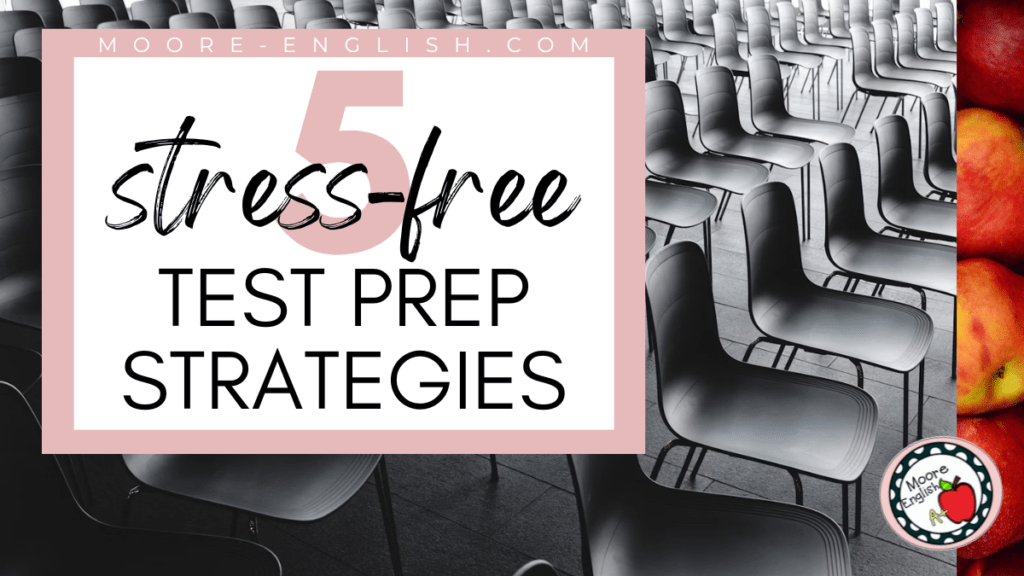Walk into a public school during the spring, and the stress of standardized testing will hang in the air. Teachers will be gray under the eyes, and tension will line their foreheads. Students will be on edge. Admin will pace through the hallways, jumping on procedural violations.
If you have the worst luck, a state agency will send a heartless drone to observe your students while they test. No pressure, folks.
Unsurprisingly, I’ve never met a teacher who advocates for the dubious benefits of standardized testing. Instead, we just have to accept them as part of our reality. So if you’re looking for a post railing against standardized testing, this is not it. Today, I wanted to share my favorite strategies for taking the stress out of the test.
This post this post may contain affiliate links. Please read the Terms of Use.
Do Not Buy the Standardized Testing Hype
First, don’t buy the hype. I have worked for district leaders who live and die for standardized testing. But, let me tell you, even in years when my students destroyed the test, the praise afterwards was faint.
All their stress happened before the test. Then the test happened, and admin attention vanished. Perhaps more importantly, in years when my students were destroyed by the test, nothing happened.
I’m sure that’s not everyone’s experience, but my best testing experiences have been the ones where I didn’t buy into the hype. I didn’t add to the hype. I treated the test like business-as-usual. And I found that approach helped my students de-stress and didn’t harm their performance.
But Also Don’t Ignore the Test
With that being said, teachers also can’t ignore standardized testing. Chances are, standardized testing interrupts bell schedules, lunch times, and students’ daily lives. Failure to prepare students for those disruptions would increase their stress level. So talk about the test ahead of time.
Acknowledging the existence of standardized testing demystifies the subject. Take advantage of any opportunity you have to make the test less stressful for students. Here are some easy options to pull back the curtain:
- If testing changes your location and seating chart, show students where they will be testing and sitting.
- Pull up released test questions and show students some of their features.
- Similarly, pull up the testing platform and let students play with the tools. Is there a line reader, a magnifying glass, an answer eliminator, a highlighter? Exposing students to different tools increases the likelihood that they will use them.
- Finally, establish norms and procedures for testing. What are your behavior expectations? Are there different procedures for eating and drinking, for cell phones, for going to the restroom?
My favorite way to introduce the topic of standardized testing is with a KWL chart. Students work with a partner to identify what they already Know about testing and what they Wonder about testing. Then, as a class, we discuss those answers and work to Learn about the test.
On the surface, this may seem like a silly strategy and a time suck. While it does take about 15 minutes, I have found that those 15 minutes are valuable because they take some stress out of the test and limit classroom interruptions later on.
As the test grows closer, we can also periodically revisit the KWL chart to see if we have new questions or concerns.
Test Prep Strategies
The best test prep strategy is good instruction all year long. If you know your standardized test includes select-all-that-apply questions, then it is best to practice with those question types all year long.
However, in the weeks leading up to your standardized test, you may wish to do some special test prep activities. These are some of my favorites:
- First, I love a good escape room! This is perfect for the Friday before testing. It expels a lot of energy and gives students a chance to practice test-taking skills.
- Second, if you really want to go big with test prep, a Test Prep Olympics is fun and dynamic. An Olympics-style test prep can also engage students across classes, creating a kind of test-prep community.
- Finally, task cards can become bell work leading up to standardized testing. If you have a sense of what kinds of questions will be on the test and/or the kinds of questions with which your students struggle, you can “stack the deck” with task cards that favor those skills. Plus, task cards allow for quick and easy differentiation.












